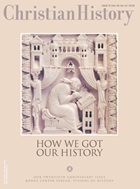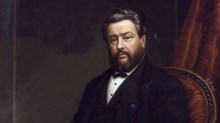When people think of medieval history, they might think of legends about saints (see Great Lessons from "Bad" History, page 22) or entries such as these from the Annals of St. Gall:
710. Hard year and deficient in crops.
712. Great flood.
714. Pippin, Mayor of Palace, died.
718. Charles Martel devastated Saxony with great destruction.
Contrast those sparse lines with this passage from medieval chronicler Ordericus Vitalis:
"When [William the Conqueror's son] Robert heard about this he was terrified. Seeing disasters all around him, he was brought low and forced to beg for mercy from the unconquered king [Henry I]. The stern king, however, remembering all the wrongs Robert had committed, resolved to hunt him down with a huge army, and press the attack until he recognized that he was beaten and submitted entirely to the king's judgment.
"Robert, driven to despair by his wretched fate, took the advice of friends and went out to meet the king as he approached the town, confessed his treason, and handed over the keys of the town to the conqueror. The king confiscated Robert's whole honor [royally granted lands] as well as the estates of the vassals who had stood by him in his rebellion, but allowed him to leave unharmed with his horses and arms, and granted him a safe-conduct through England to the sea-coast.
"All England rejoiced as the cruel tyrant went into exile, and many, fawning on the king, congratulated him saying, 'Rejoice, King Henry, give thanks to the Lord God, for you have begun to rule freely now that you have conquered Robert of Bellême and driven him out of your kingdom.'"
Medieval chronicles drew upon several sets of annals, plus oral traditions, to compose a comprehensive account. Many chronicles even begin with Jerome's Latin version of Eusebius's Chronicle, connecting local events with the span of history from creation forward.
Whether the story of a medieval town (e.g. London or Florence), an event (e.g. a crusade), an abbey, or an ethnic group, each chronicle provided an informative, purposeful, unrefined world view in which readers—or hearers—could find their identity. These four history writers produced some of the most notable chronicles of the High Middle Ages:
Ordericus Vitalis (1075-1142?)
Ordericus was an English-born monk who, after being sent by his parents to Normandy at age 10, became the foremost medieval historian of that region. He billed his Ecclesiastical History as a universal account ranging from Christ's time to his own, but he focused on life after the Norman Conquest, with special emphasis on political and diplomatic history.
Ordericus pivoted his history on biblical eschatology, describing the church's role in salvation. Current events fit into God's plan as well.
In another era, Ordericus might have been a newspaper journalist. Under his pen, William the Conqueror emerges both as a patron of churches and a man who spent his final hours struggling with a troubled past. The First Crusade is undertaken "by the inspiration of God" as Christians of the West, "from the ends of the earth and the isles of the sea," formed a united army to free the East. His personal interviews, colorful vignettes, and frequent digressions are unforgettable.
Hugh of St. Victor (1096-1142)
Probably Flemish, possibly a Saxon, Hugh became an Augustinian monk and came to the French monastery of St. Victor in about 1115. He became director of the abbey school and wrote extensively. His most influential work, On the Sacraments of the Christian Faith, sought to apply contemporary learning to worship and the lectio divina (the art of contemplative prayer).
Unlike most medieval thinkers, Hugh believed that the literal sense of Scripture was as least as important as the allegorical and metaphorical senses, and that the literal meaning must be grasped first. Because of this mindset, Hugh emphasized history as the foundation of sacred learning and virtue. Through history, he saw God's work of salvation.
On the Sacraments follows a historical, rather than theological, structure. Book One moves from Creation to Incarnation, while Book Two moves toward the Last Things. World history coincides with the history of God's people: "From the beginning to the end, no period lacks its faithful to Christ."
Otto of Friesing (1114-1158)
Born into a ruling German line, Otto became his land's finest medieval historian. Following training in Paris, he joined the Cistercian order in 1133, entering the abbey of Morimond in Champagne, where he became abbot. He was appointed Bishop of Friesing in 1137, helped reform his diocese, and took part in the disastrous Second Crusade (1147-1148).
Written at the end of his life, Otto's Deeds of the Emperor Fredrick I offered an optimistic, almost fatherly interpretation of his era. His most far-reaching work, however, was the Book of Two Cities, or Chronicle of Universal History.
Two Cities offers the first important medieval philosophy of history. Following Augustine and his younger colleague Orosius (see page 13), Otto pits the "City of God" against the "City of the Devil." In eight books, he traces this struggle from Creation to his own year—1146. The final book depicts the Last Judgment and the world to come.
Pursuing this grand scheme, Otto devalued some secular and pagan elements, becoming careless or overly rhetorical in use of detail. Yet his attention to cause and effect, his attempts to explain the present by understanding the past, and his concern "not to lose the thread of history" are consistently thought-provoking.
Anselm of Havelberg (ca. 1100-1158)
Anselm was one of the first members of the Premonstratensian order, a group dedicated to asceticism, contemplation, and active ministry. In about 1129 he was consecrated Bishop of Havelberg, in northeastern Germany on the Slavic frontier. In 1155 he was transferred to Italy, where he served as Archbishop of Ravenna.
In addition to visiting the courts of both German Emperor and Roman Pope, he journeyed at least twice to Constantinople, advocating ecclesiastical unity and political accord. The first of these journeys inspired his principal theological work, The Dialogues.
Confronted with a foreign culture, Anselm developed, as theologian Walter Edyvean has shown, "an active consciousness of human history." In Book One of his Dialogues, he uses three different schemata to advance his apologetic for the one, true church throughout the course of history. As none of these is wholly original, Anselm emerges as a student both of history and historians.
Anselm's view of history is apologetic rather than apocalyptic—unlike the view of his more-famous countryman, Joachim of Fiore (1132-1202). Presenting the grave concerns of his time, Anselm finds hope in the presence of the Spirit of God, who is able to give life and renewal to his people in any age. "With the ancient fathers," Anselm wrote, "in manifold ways by the one Faith the one God has been served."
James D. Smith III is pastor of Clairemont Emmanuel Baptist Church, adjunct professor at the University of San Diego and Bethel Theological Seminary, San Diego, and an editorial adviser for Christian History.
Copyright © 2001 by the author or Christianity Today/Christian History magazine.
Click here for reprint information on Christian History.

Support Our Work
Subscribe to CT for less than $4.25/month





























